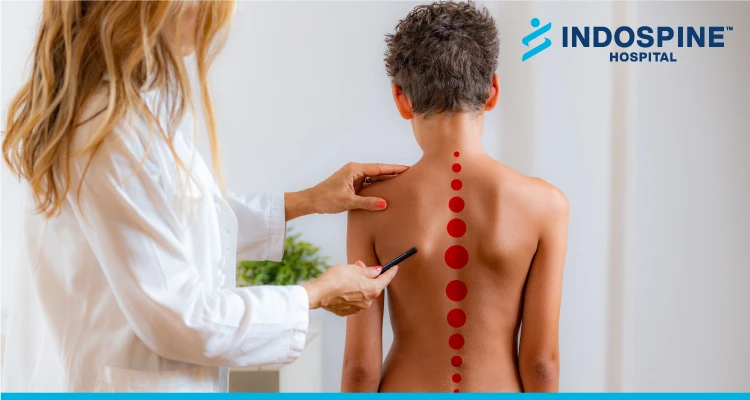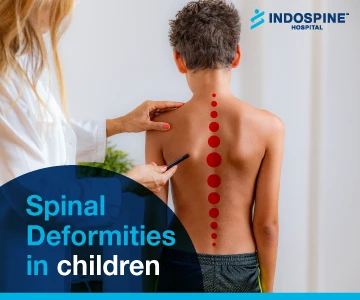Most people relate spinal deformities to an older age when it comes to spine problems. The myth often deceives people that young people don’t need spine care as the bones are strong enough. Spine care is not for any specific age group. From kids to older adults, Spine care is required. According to Ahmedabad’s best spine surgeon’s guide to spinal deformities in children, taking care of your spine from an early age can benefit you in your older age and may prevent several spine diseases.
IndoSpine, the most trusted spine hospital in Ahmedabad says, it is time to remove the thought that spinal deformities are only for those who are in their retirement stage. Spinal deformities can occur from the very birth, so it is always a wise decision to keep an eye on your child’s spine.
IndoSpine, the best spine hospital in Ahmedabad, presents Ahmedabad’s best spine surgeon’s guide to spinal deformities in children, which answers all your questions.

What does the deformity of the spine?
See what Ahmedabad’s best spine surgeon’s guide to spinal deformities in children says about what exactly deformity is.
As we all know, our spine is made up of several bones called vertebrae and connected through a cushion-like substance named discs. Spinal deformities are conditions in which the natural curve or growth is disturbed, resulting in an abnormal spine curve. (S or C-shaped curve). Normally our spine has a slight curve when looked at from the side. The spine should come down straight from the neck to the coccyx when looked at from behind.
Pediatric Spinal deformities are of different types affecting children of different age groups. Today, with the best spine hospital in Ahmedabad, IndoSpine, we will be discussing the most common pediatric spine deformities are Scoliosis which is mainly divided into 4 parts-
- Congenital Scoliosis
- Early-onset Scoliosis
- Idiopathic Scoliosis
- Neuromuscular Scoliosis
Others are Kyphosis and spondylolisthesis, a deformity of the upper spine and the lower spine.
Causes of pediatric spine deformities:-
According to Ahmedabad’s best spine surgeon’s guide to spinal deformities in children, several internal and external causes contribute to spine deformities. Based on the causes, the deformities are classified by IndoSpine, the most trusted spine hospital in Ahmedabad.
- If we talk about congenital scoliosis, it is caused by abnormal development in the spine in the womb.
- When it comes to early-onset scoliosis, it is congenital scoliosis that gets worse and is therefore named early-onset scoliosis. It is seen in children below the age of 9.
- The reason behind Idiopathic Scoliosis is still unknown and is undetectable. Researchers believe that gene mutation might be the reason, but they are still working on finding the reasons behind this type of scoliosis.
- Adolescent scoliosis is more common in teenagers. It is caused by the spine’s rapid growth, which sometimes leads to deformities, such as missing a bone, etc.
- Neuromuscular scoliosis is a deformity caused by other neurological disorders such as myelodysplasia, cerebral palsy, Duchenne muscular dystrophy, Fredrich ataxia, spinal muscular atrophy.
- Repeated trauma such as sports injury, spinal tumors, hormonal disorders can also be the reason behind spinal deformities.
Symptoms: -
Being the most trusted spine hospital in Ahmedabad, IndoSpine says, though spinal deformities do not show any symptoms at an earlier stage as it gets worse, the symptoms also become prominent. These symptoms are –
- Tilted head:
- Uneven shoulders
- Prominence of the ribs on one side
- Tilted appearance
- Back pain
Diagnosis: -
Your pediatrician may perform some tests to detect the deformity. These tests include –
X -rays: -
This is a primary technique used for detecting abnormality in spinal bones and curvature.
EOS Imaging: -
It is an imaging technique that uses a 3-dimensional image of the skeleton, making it easier to detect deformity. It is taken while the patient is standing or in an upright position. This position makes the diagnosis easier due to weight-bearing. The radiation is reduced in this technique.
Magnetic Resonance Imaging (MRI): -
In this technique, magnets, a computer, radio frequencies are used to produce organs and bone structures images. Your child has no fear of radiation exposure.
Computed Tomography (CT scan): -
In this technique, X-rays and computer technology are used, which combines several X-ray images and produces cross-sectional images that provide more details than X-rays images.
Bone Scan: -
This is a nuclear imaging test used to ensure the health of the bones. It detects bone diseases.
Positron Emission Tomography (PET): -
A radioactive sugar is used in this technique. It is injected into the body through veins. It detects the areas where diseases can occur.
Ultrasound: -
Images of internal organs and structures are produced by ultrasonic waves. It has no exposure to radiation.
Treatments: -
Learn about the treatments from Ahmedabad’s best spine surgeon’s guide to spinal deformities in children.
Treatments vary from person to person. Your pediatrician would suggest a treatment that is suitable for your child. Here are some treatment procedures-
Non-surgical Interventions: -
Every spinal deformity or disorder does not need surgical interventions. Doctors may suggest non-surgical procedures such as braces depending on the patient’s condition. These braces defend the spine from getting worse. This defense can delay or avoid surgery if the bracing is successful. But instructions should be followed appropriately. Doctors will prescribe a routine of wearing the braces and suggest some movement restrictions.
Surgical Interventions: -
There are 2 most common surgical treatments available when it comes to surgery. One is growing rods, and another one is spinal fusion.
Spinal Fusion: -
This type of surgery is performed when the child’s physical growth is completed. Bone from other areas such as hips or pelvis is used to join the bones of the backs, and rods are installed. The rods act as support until it is healed.
Growing Rods: -
In this surgical technique, rods are used to stabilize the spine without restricting the growth of the spine. The rods are installed without harming the growth tissues. The rods are lengthened to keep up with the growth of the spine. The rods may be changed for maximum expansion according to the spine growth.
VEPTR: -
This technique is used in a condition called Thoracic Insufficiency Syndrome. It is a condition in which the abnormal curve of the spine affects the ribs and lungs, leading to difficulty in breathing. Vertical expanding prosthetic titanium ribs (VEPTR) stabilize the spine curve, reducing the pressure from ribs and lungs. It is also adjusted like the rods to keep up with the spine growth.
Psychosocial Issues: -
Spinal deformities do not only affect the physicality of a child but the mind as well. Children with postural deformities become a victim of bullying. Doctors should be aware of the psychosocial issues and provide the emotional support that a child needs. It boosts confidence and makes the treatment process a lot easier.
Conclusion: -
Spinal deformities can have a significant impact on your child’s life. So, it is advisable to keep an eye on their posture from the beginning and not ignore any symptoms or pain. IndoSpine, the most trusted spine hospital in Ahmedabad, provides a wide range of treatments for spine problems for every people.


